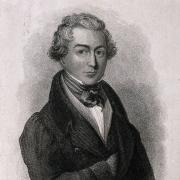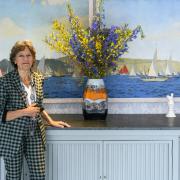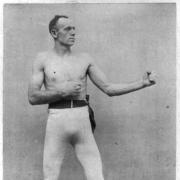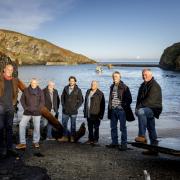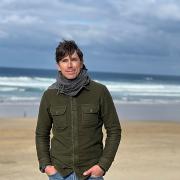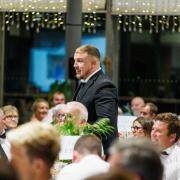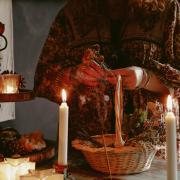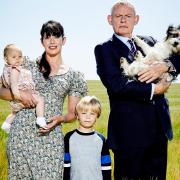It takes stamina and self-reliance, but that hasn’t stopped certain individuals from leaving the mainland to live on a tiny island off the Cornish coast.
Given the humdrum of daily life, it’s little wonder people find themselves daydreaming about what it’d be like to swap the din for somewhere secluded.
A few intrepid types, with the appropriate means and drive, go on to make it reality, such as Mary Considine who’s written The Island House about her time living on Looe Island.
Situated just off Looe on Cornwall’s south east coast, the historical 22-acre island, also known as St George’s, is now a nature reserve cared for by Cornwall Wildlife Trust but Mary remembers the small, idyllic isle when sisters, Evelyn ‘Attie’ and Babs Atkins, still owned it.
‘They were formidable free spirits who bought the island as middle-aged women in the 1960s. Attie, the older sister, was a force to be reckoned with, and Babs was the bravest person I ever knew. She had a real sense of duty to the island. After Attie’s death (in 1997 at the age of 87), she could’ve gotten millions for it but bequeathed it to the Cornwall Wildlife Trust because she wanted it looked after properly.’

Mary’s first visit to the island was at the age of seven after her mother had spotted an advert for a holiday cottage in the Farm Holiday Guide of 1979.
‘In those days, there wasn’t quite so much control about where people went, so we really had the run of the place. It was a huge playground of beaches and woods, just beautiful and wild.’
Over the years, she returned for family holidays, and as a volunteer, and then in 2010 moved there full-time with her husband, Patrick.
‘It’s something we’d always dreamed about, but it had just seemed so impossible, a fantasy, but then various events happened in our lives that pushed us away from our life in London,’ recalls Mary who remembers the exact moment they made the decision.
‘We were looking after the island while the wardens were on holiday, ambling about, thinking wouldn’t it be lovely to live here, and Patrick said, ‘Let’s just do it, let’s call the trust and ask’.’

They were allowed to become tenants, in return for renovating the old Island House. ‘That was it, we never looked back,’ says Mary. Not even on their first night in the house, one of three stone buildings, where the sisters once lived.
‘By then it had lain empty for several years, so it was pretty derelict. The windows were broken, and it was dark, cold and damp, but blowing up the air mattress and climbing into bed, I remember feeling happier than we’d ever felt. It was the right place to be.’

They fell into a contented routine of remote work, renovations and necessary tasks around the house until 2016 when they were forced to leave due to Patrick’s poor health, and now live in ‘a relatively remote spot’ in North Devon.

‘If it hadn't been for that we would still be there, unquestionably. The island’s just been the one constant in my life, and will always be a part of me, whether I’m physically there, or not, and I can’t imagine not going back,’ says Mary, who depicts the romanticism of island life, even in the depths of winter when wild storms rage, as well as the harsh reality.
‘We were told before we went there, this is not a place to run away to. Being cut off can be exhilarating, as well as frightening, so it’s definitely not a soft option, but if it's what you want, then it's the most incredible thing to do.’

An island for wildlife
Mary’s advice for the two volunteers chosen by the wildlife trust to live on the island this summer is ‘make the absolute most of it, and relish it’.
‘You’re not going to have a hot shower everyday but the wildlife and views make up for it.’
The volunteers, a young married couple from Bedfordshire, are currently living in a tent for four months while they help the permanent wardens, Claire Lewis and Jon Ross, with the day-to-day management of the reserve.
‘It’s getting so busy and we need the support,’ says warden assistant Claire, who lives on the island all year with her partner Jon.
‘Jon started as the warden in 2004 when the Cornwall Wildlife Trust was given the island as they needed someone who could take stock of everything, and then I started when it became clear it’s a role for more than one person.’

Aside from general maintenance, one of their main tasks is to monitor the island’s incredible and diverse wildlife.
‘It’s probably the biggest breeding colony in Cornwall for great black-backed gulls, the world’s biggest gull. It’s also a nesting colony for cormorants, shags, and oystercatchers who lay their eggs on the ground, so can be vulnerable to trampling. We get around 20 nests around the island but because we manage the access, they can be successful here. Butterflies and insects thrive as we don’t use artificial pesticides, and we also have seals all year round. We can tell them apart by the patterns in their fur and take photographs, without disturbing them, as part of the monitoring project.’
Wildlife disturbance, particularly in a county as popular as Cornwall, is a concern.
It’s why people visiting the island should only arrive by the trust’s authorised boat, which leaves from East Looe from Easter to the end of September.
‘The number of day trips is weather and tide dependent, but it’s a tiny boat for 11 passengers, so there’s low footfall on the island. It also means it’s a special experience for visitors,’ says Claire, whose role includes greeting people when they land on the beach.

‘We answer any questions, and provide tips, but there’s also a clearly defined circular trail around the island to minimise the impact, and visitors have around two hours to explore.’
Although the trust can manage access on the island itself, it’s a different matter what happens on the water, which is why the team is keen to remind people not to get too close to wildlife, whether on land, or in the sea.

‘People just don’t think, and will spend time trying to get a selfie. The wildlife don’t know whether a person’s a friend or foe, which can cause stress when they should be resting or feeding,’ says Claire who’s keen to continue the crucial work on the island, however isolated it can be.
‘As long as the trust is happy with our role, and we’re able to do the job, we’re content to carry on and contribute to looking after the wildlife and what’s really a very special place.’

The Island House: Our Wild New Life on a Tiny Cornish Isle by Mary Considine is published by Monoray, £16.99
Return boat tickets to Looe Island (paid to the boatman) cost £10 per adult, and £5 per child. The landing fee (paid on the island) costs £5 per adult and £2 per child. Call 07814 264514 to book your trip. For more information, visit cornwallwildlifetrust.org.uk




